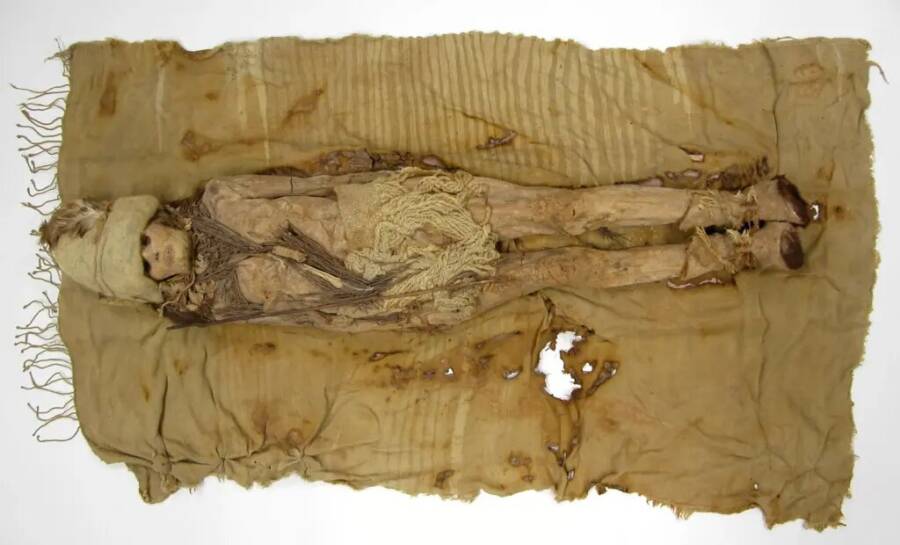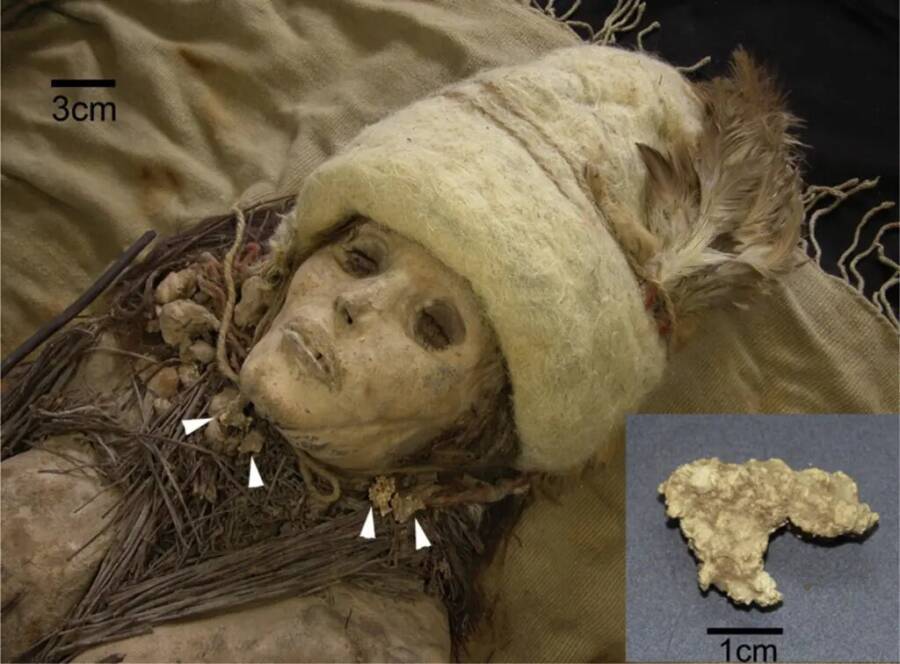While the ancient dairy product was described as "really dry, dense, and hard dust," it was once soft kefir cheese made from the milk of both cows and goats.

Wenying Li/Xinjiang Cultural Relics and Archaeology InstituteThe cheese-covered mummy was first discovered in northwestern China in 2003.
In a groundbreaking step in the history of cheese, researchers have finally solved the enduring mystery of the bizarre chunks discovered nearly two decades ago that were buried with 3,600-year-old mummies in the Xinjiang region of China. DNA analysis revealed the substance to be the “oldest known cheese sample ever discovered in the world.”
This discovery has granted researchers an extraordinary opportunity to trace the lineage of the bacteria and yeast strands in the ancient dairy product. It’s also revealing new information about the culture of China in 1500 B.C.E.
Archaeologists Discover A Mummy Adorned With Cheese

Yimin Yang et al./Journal of Archaeological ScienceThis woman was buried with chunks of kefir cheese around her neck 3,600 years ago.
More than 20 years ago, researchers excavating the Xiaohe Cemetery in northwestern China’s Tarim Basin unearthed the remains of several mummies dating to the Bronze Age (3300 B.C.E. to 1200 B.C.E.). At least three of them, including a female mummy that was 3,600 years old, had hard chunks of a strange substance arranged around their necks.
Now, scientists have determined that the substance is the world’s oldest known cheese. A new study, published in the journal Cell, specifically identified the ancient dairy product as kefir cheese.
The study authors wrote, “Due to the presence and abundance of proteins from ruminant milk, lactic acid bacteria, and yeast in the samples, these dairy remains have been identified as kefir cheese… These ~3,500-year-old kefir cheese samples are among the few dairy remains preserved more than 3,000 years and were produced by the Bronze Age Xiaohe population.”
The researchers then sought to determine exactly how the cheese was produced. Because the history of dairy products is often clouded by a lack of physical evidence, this discovery offered researchers an invaluable opportunity to shed light on the cheese production practices of antiquity.
“Food items like cheese are extremely difficult to preserve over thousands of years, making this a rare and valuable opportunity,” study author Qiaomei Fu, a paleogeneticist at the Institute of Vertebrate Paleontology and Paleoanthropology in Beijing, said in a statement. “Studying the ancient cheese in great detail can help us better understand our ancestors’ diet and culture.”
Tracing The Origins Of The Ancient Kefir Cheese

Yimin YangThough the cheese was once soft, scientists now describe it as “really dry, dense, and hard dust.”
Through DNA analysis, the research team discovered that the kefir cheese was made of both cow and goat milk. Their examination also revealed species of bacteria and yeast that caused the milk to coagulate into clumps called kefir grains. These grains were then used to produce the soft kefir cheese. The process of making the cheese would have reduced the lactose content enough for the lactose intolerant Xiaohe population to digest it.
The goat DNA found in the cheese, in particular, showed a connection between the Xiaohe and the Eurasian steppe. It is likely that interaction between the two areas occurred in ancient times, and the two groups shared cheese-making practices.
“It appears that the Xiaohe population actively adopted animal husbandry from steppe culture and that the related fermented milk product, kefir cheese, became an important part of the Xiaohe culture and subsequently spread further in inland East Asia,” researchers wrote in the study.
DNA analysis of the cheese even showed preferences for specific bacterial strains. Ancient communities in Xiaohe often shared strains that produced less gastrointestinal distress. Additional study into the bacterial strands may reveal how these organisms have evolved over the last 3,600 years.
As of now, these samples of kefir cheese are the oldest ever discovered. With their origins revealed, the only enduring mystery left is why the ancient people of Xiaohe buried the cheese with their deceased. That, we may never know.
After reading about the world’s oldest cheese, dive into the story of casu marzu, the illegal Italian maggot cheese. Then, learn about Xin Zhui, the ancient Chinese mummy that’s extraordinarily well-preserved.





